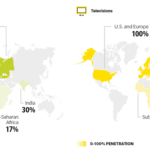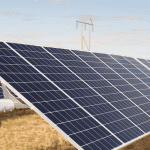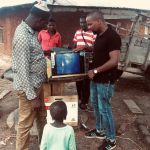Beyond Energy Efficiency: Key Trends and Pathways to Scale in the Solar Appliance Market
Energy efficiency is often overlooked as a key to unlocking higher tiers of energy access. Efficiency for Access, a global coalition working to accelerate clean energy access through high-performing appliances, was founded on the hypothesis that energy-efficient solar appliances could help consumers in resource-constrained settings run more products for longer, reducing energy-related costs and maximizing socio-economic impacts. Since 2017, we have supported research, technology R&D and other market-building efforts to make the case for including solar appliances in global energy access efforts, and to spur innovation across the sector.
Almost five years since our inception, a growing body of evidence now supports our hypothesis, demonstrating a critical link between energy efficiency and energy access. The off-grid solar “tent” has expanded, too. We estimated 282 companies were selling solar appliances in 2017 – today that number has grown to nearly 480. The diversity of products sold on the market has also grown, ranging from large agriculture technologies like solar mills and walk-in cold rooms, to on-grid household staples like electric pressure cookers and two- and three-wheeled electric vehicles compatible with mini-grids.
To take stock of this blossoming market, Efficiency for Access published the 2021 Solar Appliance Technology Briefs, which characterize the market, trends and pathways to scale for 11 off-grid-appropriate solar appliances and enabling technologies. By our estimates, no appliance is close to reaching market saturation, despite considerable gains in recent years. With less than 10 years left to ensure affordable, reliable, sustainable and modern energy for all, it is time to increase the ambition of global energy access efforts. Achieving 100% global electrification is not enough: We must also make sure that people have the appliances they need to access the cooling, connectivity, communications, mechanization and mobility that will improve their health, education, productivity and livelihoods. In this article, we explore what we’ve learned about building the appliance market and boosting access for customers, and where we hope the sector will head next.
ENERGY EFFICIENCY MATTERS, BUT IT CAN’T TRANSFORM SOLAR APPLIANCE MARKETS ALONE
The first wave of solar appliances consisted of small products with low power requirements, making it relatively easy to design broad interventions to catalyze innovation and growth. Thanks to coordinated action, these products are more efficient than ever before. On average, solar TVs tested through our programs in 2019 were 149% more efficient than they were in 2018—with some models even more efficient than those sold in Europe. Similarly, fan efficiency improved 43% between 2018 and 2019, likely driven by the adoption of more efficient motors. These improvements are enabling customers to power more appliances with their solar home systems, strengthening the business case for community mini-grids and unlocking more productive uses of energy.
Today’s landscape, however, is more complicated. Solar appliances are larger and more complex. With over 700 million people still without access to modern energy services, it has become increasingly clear that we must look beyond efficiency and adopt a more holistic approach to market interventions. Without addressing pervasive issues like affordability, appliance availability and the enabling environment, it is unlikely that the full potential of solar appliances will be realized. Figure 1, below, highlights some of these key issues.

HIGH-PERFORMING PRODUCTS CAN’T HELP IF CUSTOMERS CAN’T AFFORD THEM
Affordability continues to be a double-edged sword, impeding market growth. For companies, there’s an ongoing inability to access working capital and financial investment, and this has been exacerbated by the COVID-19 pandemic. For consumers, there’s a lack of end-user financing to make appliances attainable. Ten of our 11 Solar Appliance Technology briefs found affordability to be a major barrier preventing solar appliances from moving along the market development curve, based on price data and anecdotal evidence from consumers and providers alike. This challenge can be seen in the gap between actual and potential appliance sales. According to sales data from the first and second half of 2020, solar water pump sales among all participating GOGLA affiliates stood at 11,400 units, paling in comparison to the estimated addressable market of 700,000 households in Africa alone. Without financing improvements, this mismatch between sales and market potential for solar appliances, especially less mature technologies, will persist.
All solar appliances stand to benefit from the positive effects of appropriate subsidies and incentives. To that end, industry stakeholders are advocating for more unified, appropriately designed results-based financing programs to mainstream and simplify subsidy access. Programs like the Global LEAP results-based financing mechanism play a critical role in assisting the development of these emerging appliance markets and in expanding access – especially among marginalized groups, like women. To overcome affordability barriers, companies should also develop viable financing schemes and experiment with business models that address affordability challenges. To support these efforts and address financing barriers, donors and financiers can increase grant funding and high-risk capital, and invest in sustainable funding models for public-good technologies – from information and communications technology such as computers and internet modems for use in healthcare or school settings, to agro-processing equipment to assist smallholder farmers and farming communities.
JUST BECAUSE CUSTOMERS CAN AFFORD A SOLAR APPLIANCE, DOESN’T MEAN THEY’LL FIND (OR WANT) IT
High consumer awareness of solar appliances and strong consumer-centric design are key to market growth. Low customer familiarity with solar appliances remains a hurdle to scaling sales. This holds true for many solar appliances, regardless of their relative market maturity. For example, we interviewed 400 commercially oriented farmers in Tanzania. While most irrigated their land, there was very low awareness of solar pumping technology – and no uptake.
Even if the solar appliance sector addresses affordability issues, we will not see a conversion to sales unless consumers are better informed of the choices available in the market. Consumer awareness campaigns can help. Likewise, big-data-driven mapping efforts and effective last-mile distribution strategies can help ensure that high-value products are appropriately targeted and distributed to markets with low availability. For instance, a recent unpublished baseline survey for an ongoing Efficiency for Access consumer awareness-raising campaign for solar water pumps in Kenya found that 96% of the 189 farmers surveyed said they would consider solar water pumping once introduced to the technology. However, only 25% knew where to buy solar water pumps, underscoring the need for consumer education.
Feedback from customers can also benefit design and servicing decisions, from appliance durability, to aesthetic and cultural preferences, to right-sizing equipment. Feedback from solar water pump consumer research has led Efficiency for Access and its partner companies to focus more on durability. But usability and accessibility are also important considerations for manufacturers, requiring them to understand the needs of women and people with disabilities, as well as local cultural considerations. For example, diesel mills are challenging to operate, which can inhibit the participation of people with disabilities. In response, manufacturers can design solar mills with push-start button mechanisms to help lower these use barriers.
BUILDING SOLAR APPLIANCES FOR THE LONG HAUL
Effective quality assurance programs and appropriate policies are critical to the long-term health of the solar appliance market. Purchasing a solar product has always been a major decision for most consumers in emerging markets, but the stakes are even higher now. Today’s solar appliances are larger, more complicated and more expensive than ever before. For 50% of off-grid consumers, the average best-in-class solar water pump costs five times more than their allocated budget for energy and appliances. A faulty product could be financially devastating for a consumer, while multiple negative experiences across a community can collectively harm the reputation of solar appliances.
Accurate product performance data, test methods and standards all have a role to play in ensuring that the solar appliances available on the market are safe and reliable. Programs like VeraSol aim to fill critical testing and knowledge gaps by expanding the global testing infrastructure and providing market actors with the comparable, third-party testing data they need to make informed purchasing decisions. VeraSol and the Global LEAP Awards are also working to lay the technical foundation necessary for a more mature market by developing standardized test methods and quality standards for solar appliances, and optimizing quality assurance for nascent technologies through a combination of lab and field testing. Many procurement programs and development institutions now require proof of third-party testing or quality verification to be eligible for funding. In the future, governments may also wish to adopt these test methods and standards as part of a broader quality assurance initiative.
WHERE DOES THE SOLAR APPLIANCE MARKET GO FROM HERE?
In order to unlock the full benefits of energy access, we cannot look at each solar appliance technology in a vacuum. New partnerships, more funding and continued innovation will be critical to getting more solar appliances into the hands of consumers and closing the energy access gap. To that end, we must look beyond the energy access sector to a broader ecosystem of partnerships that enable the “energy as a service” business model. In most cases, sector silos reduce the efficacy – and availability – of solar appliances. For instance, agricultural productivity could be improved with greater coordination between the energy, agriculture and water sectors, while healthcare outcomes could be bolstered by more interconnected energy, health and infrastructure partnerships. And the entire development community would benefit from an enabling policy environment that appropriately taxes solar appliances and reduces costly delays, and one in which the agriculture ministry knows to engage with the energy ministry, for example, to deliver sustainable development co-benefits together.
From the beginning, the global energy access discourse has run parallel to the broader climate and energy agenda. The 26th UNFCCC Conference of the Parties (COP26) presents an extraordinary opportunity to bridge cross-sector gaps between energy, water, agriculture and health, just to name a few. Appliances can help serve as a conduit for a diverse ecosystem of actors working together toward our shared climate and sustainable development goals.
COP26 also presents an occasion to align efforts and financing to advance energy access and improve community resilience to climate change. Many nations are already feeling the negative impacts of climate change, and there is a need to provide additional financing to help them adapt to a warming world. Initiatives like the US $25 billion Africa Adaptation Acceleration Program, which aims to improve the continent’s adaptive capacity while tackling COVID-19 and emerging economic challenges, are a good start – but more work is needed. Further funding, alignment and capacity development for solar energy and appliances as a part of regional resilience and adaptation plans would not only bolster households’ abilities to adapt to a changing world, but would also empower a younger generation by diffusing the technologies they need to achieve a good standard of living.
At COP26, Efficiency for Access will team up with ICF and the International Energy Agency to co-host four energy access-related events at the COP26 Resilience Hub, which connects people, communities, businesses and cities from across the globe working at the nexus of climate change and development. We will also be present at the Sustainable Energy for All SDG 7 pavilion.
To learn more about the solar appliances and equipment market, read our 11 Solar Appliance Technology Briefs and our Synthesis Report.
Yasemin Erboy Ruff is a Manager, and Lauren Boucher is a Senior Associate at CLASP.
Photo courtesy of CCAFS/2014/Prashanth Vishwanathan
- Categories
- Energy, Environment, Technology



